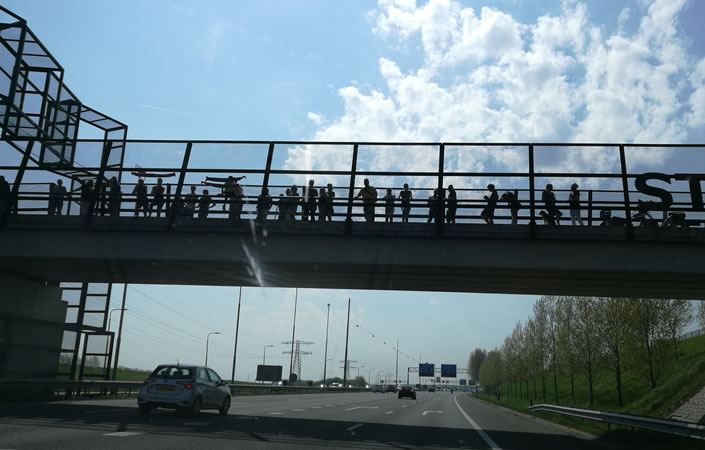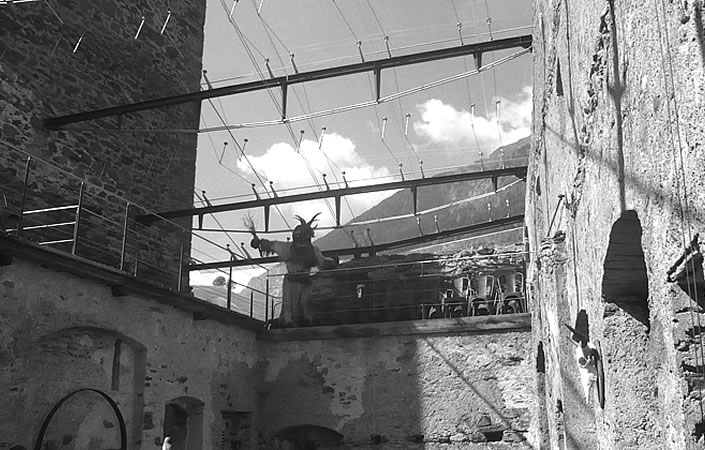2. March 2020

Few remarks on the announcement of the bad news
It is an event that captures the attention of the managers involved. Although it is only one step in a longer process, it is the central event because it sets the tone for the whole following process: the official first announcement.
Moderating such an event requires high emotional stability, the ability to perceive moods in a group early on and to address them sensitively. Without such control, misunderstandings, multiple sensitivities and unrecorded emotions take over the direction of the event.
It is important to involve all managers in the preparation – because they determine an important part of the evaluative assessment of the situation in side conversations, in their posture, in what they do not say and what they say afterwards – they are an important part of the social calibration. Often they are not involved enough, it is overlooked that they themselves are also affected and by preparing for the event and the process afterwards, they also have to and can clarify their own attitude. The mantra applies: Show presence!
It is understandable that intensive preparation is shunned again and again – one deals with an emotionally stressful and difficult topic and sometimes the desire to have already left it behind outweighs. However, with a joint intensive preparation of this event the foundation for the sustainability of the whole following process is laid and this process is not linear, it needs the ability to work iteratively as a leadership group and to deal with surprises, reversals and corrections.
Too often, very differentiated presentations are shown – they are politically and legally coordinated and usually too complicated. It is therefore important to work with the executives on stage to turn the complicated and differentiated slides into simple statements – at least when speaking. It’s all about striking the local tone.
Always too short, too loveless, only partially understanding the importance – the dialogue part of the proclamation. Here it is not just about asking questions, but about creating space for speaking. There are often only statements that ask nothing, but say what is happening emotionally. This space is of high importance, because here the people experience whether it is also about them or only about the handling of an economic problem. Here it is also conveyed that it is good, right and allowed to show emotions. After all, this is a situation in which then also the managers are no longer only preachers and explain, but also become visible and perceptible in their own emotionality. In these moments the feeling of togetherness, of being together, is created, even if the tasks and concerns are very different.
If an employee who knows that he will lose his job and who is still at a loss as to what to expect, goes to the responsible manager after such an event, by looking into his eyes and saying: »This is really bad and I don’t know what I can do now, but thank you for your clear words«, then together – the moderator, the managers and the group – have laid the foundation for a process in which everyone knows: We do the best we can in this situation and we do it for the community of all people who are affected.
Rüdiger Müngersdorff, Fetiye Sisko
Photo: David Straight by unsplash.com
2. March 2020

The dilemma of local leadership or A deep conflict of loyalties
There’s the decision. Costs have to be reduced, a reduction in staff is pending, perhaps the closure of a site or the sale of part of the company. The local management has the task of implementing the decision. A difficult task that plunges many managers into conflicts of loyalty. They themselves are insecure, but they want and should ensure that they act in a considered and secure manner.
So what happened before there was broader communication? There was a decision by headquarters – the local managers were hardly involved in this process, and if they were, then mainly as suppliers of analyses, data and information. With the decision, the task of implementation lies with the local management, which at first perceives the interfering support of the head office as helpful, but later, above all, as disturbing. The task now is not only to inform the people, to take their concerns and needs seriously and accompany them, to negotiate social packages, to start initiatives to give the affected MA an opportunity outside, but also to maintain productivity until the last day. The contact to the own employees becomes more intensive, they move much closer with their lives and the expectation develops that the local leadership will do everything to protect, maintain and maintain the own organisation. Naturally, conflicts arise here between what a head office wants and what local employees expect – and the responsible local management stands between both expectations. The personally challenging task now is to keep both interests in balance and to stay emotionally balanced. Good managers feel deeply committed to both sides – to the employees in their need, their worries and uncertainties, to the company that made such a decision for good reasons and with an eye to the bigger picture. A dilemma, often a moral dilemma, but always an emotional dilemma.
A particular challenge is to compensate for the loss of credibility that is inevitable from the very beginning. At the beginning, the local management already knows what is going to happen, but is bound to secrecy by very strict confidentiality agreements. If communication then takes place, one of the first accusations made by employees is: Why did you keep quiet for so long? How are we actually supposed to trust you, since you were involved in all this?
It is a difficult task, a task that deeply questions your own belief system. It is a task for which most managers are not prepared. How can they behave? How can they make room in the contradictions, the head and the heart equally? How can they deal with their own insecurities and worries and not let them distract them from their task?
Should managers be accompanied in such tasks? In all social professions it has proven to be a good idea to offer supervision for individuals as well as for teams. The point is to be aware of the situation and one’s own actions even in difficult situations. Only a guided self-reflection can help to be able to act and to act in the interest of all participants. We have had very good experience with a supervision approach in all the processes we have accompanied. The support helps all sides – the head office because it achieves its goal, the local management because it does not betray the interests of either side and can leave the process even with a clear awareness, and the employees because only a stable local management can ensure that new options for their own future can emerge even in this emergency.
Rüdiger Müngersdorff/Fetiye Sisko
Photo: Mauro Mora by unsplash.com
2. March 2020

Transparency makes credible – the need for honest leadership
It is a classic starting situation: A general manager, a plant manager, a divisional manager is informed that significant redundancies are imminent in his area, that a site is to be closed or an entire business unit sold. There may have been a hunch, and yet it is always shocking. The person in charge experiences what he will have to communicate to the employees in the near future. And he/she very quickly feels that he/she feels left alone and that he/she only receives reliable information in slices. The situation is confusing and will remain so for quite some time. It is the first scene in a process that now follows, in which every scene has to be rethought and redesigned again and again.
SYNNECTA has been supporting companies and responsible managers for many years in the design of such processes, which focus on communication. It is a different kind of communication – it requires a much higher degree of transparency, honesty and credibility than standard communications and it cannot be delegated. The communication cascades are already problematic in normal times, in crisis communication they are dangerous – the uncontrollable infectious rumor bags are created.
Our affected manager has a first task – he/she must form a team, a management team, which is able to deal sensitively with the situation from their own concern and is prepared to show a high level of presence throughout the entire process. We know the closure process from managers who like to visit the headquarters in such times. The management team with clear knowledge of the task and an honest willingness to go down this path with all employees is the backbone of the process. It is the time when the local managers, the micro-politics learned in seminars and their own tactical behaviour have to leave behind. Fetiye Sisko, who has supported many companies in these phases, says that in the beginning, support always involves developing a common attitude, which makes it clear that the focus is always on all the people concerned.
The people entrusted with communication are too often still young employees, without their own network, with little experience and little influence on content. Their commitment is often remarkable and yet they need support. Because crisis communication has a few special features. Again and again we experience phases of confusion, anger and rage when discrepancies become visible on the various communication channels. In particular, synchronised external and internal communication is required – any discrepancies spread by the press, social media, etc. must be included in internal communication. This is the only way to prevent irritations from the outside to the inside and to avoid strong emotional reactions. Differences in communication create mood and the situation is unstable.
The lively Q&A is an important component in successful crisis communication – every question stands for a need and a necessity, every question must be answered. And if it cannot be answered in the status of the process, exactly this must be said and justified. This is the only way to actively shape the mood part of a crisis and, as experience shows, to prevent the emotional substitutes such as actions of sabotage, refusal to work, etc. This also makes it clear that crisis communication is an iterative process; none of them proceeds in the way that very clever people, who are far away from what is happening, have imagined in advance.
As we have already said, delegation to a communication cascade is not helpful – it creates differences in communication and is no longer controllable by the responsible management team. Therefore it is essential for us to communicate with everyone at the same time as often as possible. Dialogue is already important in a normal situation, here it becomes decisive. It is one of the aims of crisis communication to reduce rumours, and for this to happen, joint communication experiences are needed. They are emotional, sometimes turbulent in the middle – but what happens in a meeting does not happen outside. Of course, this requires an experienced moderator who is able to keep an overview even in emotionally violent reactions and who can behave with appropriate empathy towards everyone.
We have had good experience in organising communication meetings together with the works council, employee representatives and management. This is where similarities become visible and differences become transparent. Each side has a different role and yet they are jointly responsible for shaping the situation for the people. And here again, every concern is to be taken seriously. In one case, the management had a reduction target which in their eyes was marginal (below the 10% mark) and therefore did not consider extensive communication necessary. One morning, the managers came to the site and saw 100 scarecrows wearing black T-shirts by the fence. It was the number of those to be dismantled. It may hit 100 people in the end, but in the beginning it hits everyone. And the principle is, what you do to one, you do to all.
There are many important characteristics of crisis communication – its quality makes a big difference, for the employees concerned and for the company. It takes experience to design such processes – and always a high level of emotional competence. Managers who have to deal with insecure people on a daily basis, and who are often insecure themselves, need support in these phases. If the attitude in the management circle is right, a constant empathic behaviour can be learned. Transparency, honesty and empathy are essential behavioural aspects in these processes. We at SYNNECTA are happy to do this task, even where it is very difficult, if one thing is given: the responsible leadership wants to make the process as honest and appreciative as possible for all those involved.
Rüdiger Müngersdorff/Fetiye Sisko
Photo: Hanna Göhler
6. July 2017

A process of change can take on many guises. It can be a major crisis or a great opportunity. Yet every single process of change involves two decisive components: Anxiety and Trust. There is no certainty in life. It is never there, but its absence is most apparent in processes that are first and foremost about change.
Uncertainty, however, creates anxiety. Uncertainty about what we are facing implies potential danger. Potential danger is the basic trigger of anxiety. Part of our fear of that which we do not know is anticipatory anxiety: the fear of fear itself. This anxiety is the kind of fear that paralyses us humans more than anything else. It makes us blind. Chronic anticipatory anxiety and excessive fear block a clear view of reality and thus disable the ability to perceive potential. It prevents learning, flexibility and development. These, however, are tools that are essential to surviving a crisis.
The success of a process will hinge on your attitude towards fear and anxiety (your own as well as that of your colleagues) and the way this attitude affects your relationship to confidence and hope. What courses of action are open to managers in a situation that is shaped by uncertainty? How can they reduce anxiety and establish trust; how can they make sure that they and their employees will not fall into a state of anxious paralysis in the face of potential danger and threat? If you allow room for these questions and attempt to find answers to them, you will be able to master any crisis.
Fear: Processes of change entail concrete threats for all those who are involved. These can include the loss of a workplace, status loss, an increased workload, the fear of not being good enough. Each process of change has its winners and its losers. These fears are real or are felt to be real and refer to potential realities. They are concrete and relate to a particular issue.
Anxiety: Diffuse anxieties do not need to be directed towards a given object. These are basic anxieties that are contained in the essence of human existence and are differently well developed in each person, depending on personal histories. They emerge in response to individual triggers.
Managers can respond to both fear and anxiety in positive ways. Basic anxieties include:
- the fear of change – experience of transience and uncertainty
- the fear of finality – experience of bondage
- the fear of closeness – experience of dependency
- the fear of individuation – experience of isolation, lack of shelter
Avoidance strategies in response to anxiety
- Avoidance: Avoidance of situations and persons who trigger anxiety.
- Trivialization: Belittling the anxiety, playing down its symptoms.
- Repression: Deflecting from the anxiety, the anxiety is numbed and protective excuses are made.
- Denial: The anxiety is utterly ignored. It is given no place in the individual’s range of emotions.
- Exaggeration: Overdrawn precautions and their compulsive repetition aim to reduce anxiety.
- Generalisation: Creating norms to correspond with individual anxieties.
- Heroization: Only the strong can handle anxiety. You are a hero.
In the short term, these strategies can reduce anxiety. However, they all result in an inability to deal with the threatening situation in a clear, appropriate and constructive manner. It becomes impossible to employ the available resources for a constructive treatment of the crisis. The potential to actually solve the crisis is thus blocked. In the long term, avoidance strategies result in rising personal anxiety levels. The avoidance strategies will increasingly fail, and this failure will cause social, psychological and physical symptoms of illness.
 More than 26 per cent of medical complaints registered in the EU are due to psychological disorders: they make up more incidences than heart disease and cancer. The greatest part of these 26 per cent are related to anxiety and depression.
More than 26 per cent of medical complaints registered in the EU are due to psychological disorders: they make up more incidences than heart disease and cancer. The greatest part of these 26 per cent are related to anxiety and depression.
Fourteen per cent of Europe’s total population have suffered anxiety disorder!
Anxiety causes personal suffering as well as a loss of creative and productive capacity: it is, beyond anything else, an enormous macroeconomic factor. The statistics of the Bundesverband der Betriebskrankenkassen [federal association of company health insurance funds] show that a quarter of all sick-leave certificates and a twelfth of all days off work in Germany are explained by psychological disorders. Since the early 1990s, the percentage of sick-leave due to such disorders has more than doubled.
It used to be the case that an employee entering a company could be certain that one day he or she would be handed a golden watch to mark their 25 years with the company. Nowadays, it can happen that everything is fine on a Thursday and the department is closing down on the following Monday. Restructuring processes in companies can trigger anxieties when they result in demands that individuals fulfil new roles that do not match their personality: for example, when an assiduous accountant with a knack for numbers is suddenly required to enter customer service and give advice. In the modern society we live in, all relationships are qualified by the possibility of their dissolution. This considerably adds to a sense of uncertainty.
What needs to be done?
1. Recognition
- The first thing managers have to do in order to properly deal with active anxieties in a situation of change is to recognize them. It does not matter whether these are concrete fears or diffuse anxieties, whether they are realistic or not.
- You will find it easier to deal with the anxieties of others when you are able to recognize basic anxieties in your own life for yourself. Once you have accepted your own fears, you will not need to resort to a defensive reaction when you are confronted with anxiety.
2. Reduction of Anxiety
The emotional opposite of fear is trust. There are two types of trust. They are interdependent:
- Trust in yourself and your own capabilities and
- Trust in others
Fear knocked. Trust opened. There was no-one there. (Chinese)
When confronted with a situation of change that triggers their anxieties, employees in a company will turn to their superiors for guidance. As a manager, you thus have to contribute to ensuring that
- your colleagues trust you
- you create situations and an atmosphere in which your colleagues can believe in themselves and their capabilities (self-efficacy).
We know from child psychology that certain experiences cause a child to lose their absolute trust in themselves and their environment. These forms of disappointment also affect adults, thus reducing their belief in themselves and their environment, e.g., their business:
I. Trust in management is lost when:
- there is a sense of being left alone; when there is nobody there when help is needed
- superiors announce something and do not keep it
- superiors appear to be acting without reason or arbitrarily, especially with regard to negative sanctions
- superiors vent their temper on their employees
- there is no continuity in management behaviour. In other words: your colleagues will only trust you if there is a clear and functional management coalition
II. Trust in one’s own person and capabilities is lost when:
- demands that are made are continuously set too high, so that employees will repeatedly experience a failure to succeed
- criticism is delivered much more frequently than appreciation is voiced
- employees feel that they are helplessly delivered to a situation
- superiors are overly protective and controlling, they don’t allow their employees the room to make their own experiences
- they cannot experience their own ability to learn, effect and be independent
- there is no differentiation between uncertainty regarding the self and uncertainty regarding the situation
- superiors or employees feel that they have to be flawless

Trust in oneself and one’s own abilities will rise, given:
Experience of self-efficacy
Whenever people experience that they can have an effect, that they are actors who make a difference, their trust in themselves will grow. This is most effective when a person has successfully handled a difficult situation. If these successes are then ascribed to that person, the expectation of self-efficacy will grow most: difficult future situations are faced with more confidence and individual failures are met with a greater tolerance for frustration.
Substitutional experience
Watching other people master a difficult task or believe that they can handle it, raises a person’s own belief in their ability to handle it. Greater similarity and proximity between the person watching and the person being watched will increase the influence the example can have.
Verbal encouragement
People who are met with confidence and benevolence and who are trusted by others that they can master a given situation are more likely to believe in themselves than those whose abilities are doubted. At the same time, it is important not to make unrealistic demands.
Emotional control
People who are able to influence their level of agitation (e.g., using breathing techniques, disciplined thought and self-reflection, sport to vent physical excitement, etc.), are more likely to believe in themselves and their self-efficacy, as they experience that they are not helplessly delivered to their own emotions and states of agitation.
Thus, the following is valid: There are many reasons to be anxious. When anxieties are recognized and not avoided, the human ability to act will be retained and people will be able to handle crises. And to stay healthy. There is no certainty. There is confidence.
Fear and joy are magnifying glasses. (Jeremias Gotthelf)
Rüdiger Müngersdorff, Katja Schröder
8. May 2015
 CEOs chose a forward-looking topic, nominated speakers and about a hundred talents each from their own organization to meet in an aeroplane hangar at the former airport Tempelhof in Berlin on Labour Day. It was a successful idea, and there was a passionate host: Gabor Steingart, CEO of the Handelsblatt publishing group.
CEOs chose a forward-looking topic, nominated speakers and about a hundred talents each from their own organization to meet in an aeroplane hangar at the former airport Tempelhof in Berlin on Labour Day. It was a successful idea, and there was a passionate host: Gabor Steingart, CEO of the Handelsblatt publishing group.
SYNNECTA participated as a guest. It was a good opportunity for SYNNECTA to see clients once again and meet the next generation as well as encountering familiar topics and pioneers.
The CEO of Bayer AG Marijn Dekkers announced risk researcher Ortwin Renn from Stuttgart, who gave a lively and knowledgeable explanation that innovation needs a culture of readiness to assume risk. He also described how the augmentation of individual risks by media leads us to seriously overestimate these while we underestimate and partly displace other real, but abstract, risks – such as global warming. The chairman of the supervisory board of Daimler AG, Manfred Bischoff, had invited physicist Michael Feindt from Karlsruhe to speak on algorisms and automated decisions that decisively raise the quality of decision-making for all repetitive decisions. However, this does not apply for strategic decisions on the way to the future, for which we cannot make use of existing data. No amount of data collection ascertainment of decisions can replace »gut instinct« there.
Jürgen Fitschen, Co-CEO of Deutsche Bank had chosen the topic trust and invited extreme climber and businessman Stefan Glowacz. He gave an authentic presentation at hand of the story of three attempts at a first ascent of a mountain in Patagonia that showed how many dimensions of trust come together to make possible the performance of an extreme achievement under extreme conditions. There is trust in one’s own plans, the material and the team as well as trust in the goal as the decisive motivator above all. Johannes Teyssen, CEO of E.ON had selected the topic re-invention and chosen American investor and multi-millionaire Steve Westly to speak. The speaker described digitalization and networking as the driving forces of a development that in themselves pose a challenge to current business models. Westly also used anecdotes to bring personalities like Steve Jobs and Elon Musk into the room: they revolutionized industries with visionary force and determined persistency.
Jens Baas, CEO of Techniker Krankenkasse nominated philosopher and journalist David Precht to illuminate the concept of appraisal. The speaker gave a fundamental explanation why people are existentially dependent on appraisal and why it is intrinsic to human behaviour. There followed rounds of conversations with participating talents that covered values such as satisfaction, fairness, love, morality and cooperation.
Bernhard Mattes, chairman of the management board of the Ford works and president of the American Chamber of Commerce in Germany announced the topic diversity for innovation. Markus Hengstschläger is a human genetics expert from Vienna. He demonstrated how our society systematically produces »mediocricy« that is produced in family backgrounds, Kindergardens and schools and even the development of business managers. We are conditioned not to attract attention, to keep in line and we have to work on our weaknesses in a system that concentrates on deficits while our outstanding abilities waste away. We live in fast, unpredictable times: we need diversty and difference in order to master the challenges it brings. Hengstschläger delivered a speech full of expert knowledge at the highest level, telling analogies, humour and a seminal message – the standing ovation was well deserved.
Gabor Steingart introduced the topic revolution and passionately advanced his conviction that the enlightenment is not a completed era but now more than ever is in fact a universal social duty that could certainly result in a modern revolution. He referenced the economist Tomas Sedlacek who had already touched on the topic from another point of view with a book on »(R)evolutionary Economics?« together with David Graeber. Sedlacek is convinced that the logic of the free market and an economy of growth that is still in place cannot be maintained.
For us, the event was a reunion with our clients, including CEOs with whom we have successfully worked together in great change projects. It was also important for us to see that the topics we are dealing with are ever more appreciated by a broader public. Value and trust have always been the basis of a sustainiable business culture. On July 5, we will dedicate a special open event in Cologne to our topic »diversity and inclusion«, which is still an untapped dimension that is instrumental to business success.
Prof. Hengstschläger gave a deeply convincing presentation of the significance of diversity for innovation. It was certainly no coincidence that the CEOs who met in the hangar at Tempelhof on May 1, 2015 were all white, middle-aged men. Our initiative »New leadership for a new world« takes account of the transformative dynamics conjured up by Westly and analysed by Sedlacek.
SYNNECTA has already established a context for this mosaic-like effective topics and supports businesses and managers on their way to sustainable modernity. The SYNNECTA future check and our organizational development approaches for agile organizations factor in the findings presented and discussed at the pathfinders 2015 event. We will incidentally discuss these approaches on June 10 with HR managers from a range of organizations in an HR round table. SYNNECTA will also elucidate them in a lecture to be held in Cologne on September 15 at Zukunft Personal 2015.
Since labour day, another 800 young leadership talents have been inspired by the topics of the future. Pathfinder 2015 was a successful event! It is good to know that more and more people are joining up to design the future together.
Jörg Müngersdorff





 More than 26 per cent of medical complaints registered in the EU are due to psychological disorders: they make up more incidences than heart disease and cancer. The greatest part of these 26 per cent are related to anxiety and depression.
More than 26 per cent of medical complaints registered in the EU are due to psychological disorders: they make up more incidences than heart disease and cancer. The greatest part of these 26 per cent are related to anxiety and depression.
 CEOs chose a forward-looking topic, nominated speakers and about a hundred talents each from their own organization to meet in an aeroplane hangar at the former airport Tempelhof in Berlin on Labour Day. It was a successful idea, and there was a passionate host: Gabor Steingart, CEO of the Handelsblatt publishing group.
CEOs chose a forward-looking topic, nominated speakers and about a hundred talents each from their own organization to meet in an aeroplane hangar at the former airport Tempelhof in Berlin on Labour Day. It was a successful idea, and there was a passionate host: Gabor Steingart, CEO of the Handelsblatt publishing group.